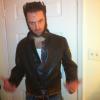Michael, the study you are referring to involved rats, so why did you give this post the title "Mess up YOUR heart with intermittent fasting"? I doubt there are any rats reading your post.
Because (a) it's a headline, not an essay (the post was clear enough, methinks), and (b) the entire issue is humans adopting EOD on the basis of the rodent studies thereon (compounded by popular misinterpretation thereof). I am not going to add an elaborate caveat about the level of scientific support for the likely translatability of rodent CR data into humans into every single CR- or EOD- or even dietary-supplement-related animal study that I post or discuss.
As discussed many times before, and contrary to what is often said or implied, there is no specific benefit of alternate-day fasting (ADF)/every-other day feeding (EOD)/intermittent fasting (IF) on lifespan, long-term health, or aging, at the same Calorie intake. Feeding animals once, twice, or several times/day at the same net Calorie intake yields the same lifespan benefit: the limited effect on lifespan boils down entirely to the small Caloric difference.
Of the very few studies in CR'ed rodents that have examined the effects of multiple feedings per day(as opposed to the ubiquitous single food ration per day), the gap between rations per day in rats was still a whopping 16 hours. That's only 8 hours less than the normal ADF feeding schedule.
While studies where the rodents are out of food ≤12 h are the minority, there are several -- including one of the direct-comparison meal timing studies
cited previously:
Female CD2Fi mice … on a daily schedule of fluorescent lighting from 0600 to 1800, darkness from 1800 to 0600 … were then assigned to four different feeding regimens … [including] six smaller meals at intervals of ~2 h beginning at the onset of darkness and ending near the onset of light, a regimen intended to approximate the pattern of ad libitum feeding (pattern-fed, PF). … Adherence to this schedule was confirmed by direct observation and also by remote recording of the activity of transensor-bearing mice, based on changes in field strength at the antennae. Thus, the longest span without food for this group was about 12 h, roughly comparable to that of ad libium controls, for which feeding is largely nocturnal."(4)
Lab animals mostly eat during waking and sleep during sleeping, and in the wild most animals including humans spend most of the dark hours asleep. I don't think anything can be read into a routine overnight "fasting" period.
I couldn't find any detailed information on the feeding regime used in the study that was the basis of your initial post to this thread, but I would assume that its "alternate day fasting" regime most likely involved 24 hours access to ad-lib food followed by 24 hours without any access to food.
If we were to use the 6:1 to 10:1 metabolic ratio of human to rat, then 24 hours without food in a rat would be equivalent to about 6 to 10 days without food in a human. [...] Trying to compare ADF in rats to ADF in humans is potentially fraught with some very obvious and very basic metabolic problems - it's in some ways akin to arguing that CR'ed humans should be eating the same *absolute* number of calories that CR'ed rats do in order to receive the same effects.
Since rats live on the same planet that we do, with the same sunrise and sunset, and (again) rarely eat during artificial or real daylight hours, I really don't think that's relevant. IAC, as documented earlier, the human data on EOD or even once-daily feeding don't replicate the
apparent (misleading) short-term metabolic advantages of EOD, whereas human CR studies show very strong parallels, as due the more invasive and controlled nonhuman primate data.
The notion that it is otherwise is the result of a mixture of wildly-extrapolated cell studies, and short-term studies (many by Mark Mattson's group) showing that EOD animals undergo a variety of favorable-looking short-term metabolic shifts, such as lower insulin and glucose levels -- and, importantly for THIS post, lower blood pressure, heart rate, and blood pressure variability ([refs]). However, these shifts, while consistent with the effects of CR proper, do not lead to life extension except to the degree that they lead to actual Calorie restriction. (Again, see links in the post linked above).
The very study that is the central focus of your post here arguably bases its diastolic dysfunction conclusion on a similar type of extrapolation and short-term study - because assuming ADF always does cause diastolic dysfunction in rats, these "dysfunctional" changes can still lead to a longer lifespan anyway.
You do have a point here, to a limited degree, except that WT rodents very rarely die OF (as vs WITH) cardiac and cardiovascular pathology, whereas these are major causes of mortality in humans. As noted already, while likely only very minor contributors to their extended LS, "CR protects rodents against cardiomyopathy, cardiac hypertrophy, interstitial fibrosis, etc; and in this case, we don't have much to argue about on the question of translatability, since "Long-term caloric restriction ameliorates the decline in diastolic function in humans" (([ref]) -- including, he notes gleefully, his own human self

)."
Don't get me wrong though, I still think this study is cause for some concern. It's not the first to show potentially harmful results to the heart from similar dietary interventions. In fact, there was this study in rats, not on ADF, but on your currently favoured CR which sounds somewhat ominous:
"Effect of long-term food restriction on cardiac mechanics"
http://ajpheart.phys...73/5/H2333.full
"In summary, FR altered many aspects of cardiac mechanical performance....some of the changes, such as the increase in the sensitivity to ß-adrenergic stimulation, were opposite to ordinary age-related trends.....Others, such as prolongation of time to peak tension and half-relaxation time, AMPLIFIED THE AGING TRENDS."
First, this study was done in isolated, perfused hearts, and all the performance metrics were after treatment with various drugs. I don't think that's a terribly relevant model to begin with, and even within that experimental model, they had a variety of incompletely-addressed challenges:
First, the number of interventions necessitated that the experiments run for ∼3.5 h. This is a relatively long time for the isolated heart preparation, especially in view of the fact that we used crystalloid perfusion. It was notable that we used coronary perfusion pressures of 60 mmHg, which tended to minimize edema. ... Second, we did not perform testing over a complete dose range of isoproterenol in our hearts. As such, the maximal response to this agonist was not defined in each heart. We feel, nonetheless, that the conclusions on sensitivity to the lowest concentration of isoproterenol are valid. ... Third, the use of isolated hearts entails many inherent weaknesses. Clearly, studies in intact, conscious animals would be preferable. Whether loss of nervous system control, alterations in temperature, use of artificial pacing, and other aspects of our procedure altered our results is not known. Because, however, each group was treated in an identical fashion, the differences we found between groups are likely to represent real effects of FR on cardiac mechanics. [Unless, of course, there IS a CR-specific effect to the conditions which don't apply when the heart is still firmly ensconced in the little buggers' rib cages and beating under their own volition -MR]
Finally, it should be pointed out that because the hearts of the different groups were of different size, the question of how to properly normalize the data from the mechanical studies is important.
By contrast, while one of the tests in the EOD study under discusssion did involve a drug-response test (dobutamine volume stress test), everything else was done under physiological conditions, and all of them in intact, living animals (except, of course, the histopathology studies, where the increased fibrosis was in direct opposition to the REDUCTION in fibrosis in CR proper, just as the reduced diastolic function and cardiac elasticity were the reverse of the findings in CR.
Secondly, the one parameter where CR "AMPLIFIED THE AGING TRENDS" was not identified by the author as being a
pathological trend, and not linked AFAIK to any known problem of the aging heart in vivo in humans.
It also appears to be rather commonly accepted that fasting and more severe caloric restriction can pose some serious risks to human hearts:
"Cardiac effects of starvation and semistarvation diets: safety and mechanisms of action"
http://www.ajcn.org/...1/230S.abstract
"A major concern with the use of starvation or semistarvation diets for weight reduction in severely obese people has been the reports of sudden death due to ventricular arrhythmias....
"Sudden death associated with very low calorie weight reduction regimens"
http://www.ajcn.org/.../34/4/453.short
"We studied the cases of 17 individuals who died suddenly of ventricular arrhythmia after prolonged use (median 5 months) of very low calorie weight reduction regimens consisting entirely or largely of protein...."
CR is not equivalent to these diets in any sense: the level of restriction is extreme, the initiation immediate, the diets piss-poor, and frank malnutrition not only present, but positively identified by Lockwood and colleagues as responsible for the problem. After a series of case reports of people following liquid protein diets presenting with arrhythmias, they performed a controlled study which confirmed the effect (3) and demonstrated the rapid depletion of some of the minerals in which the basic formula was deficient (2). But by supplementing the original diet with a broader range, & a higher quantity, of essential minerals, the cardiac abnomalities vanished (1).
This is especially reassuring as it was the most primitive possible method of improving the diet: basically, mixing in a couple of multimineral pills, rather than including a whole food with all of its nutritional complexities. Cf the 'big mac + Centrum' approach of many diets in the CR literature.
A variety of things could've accounted for the correction, but looking at the diets in (1), it's easy to see that the repletion of Mg & Cu -- deficiency of either of which is known, in humans, to cause cardiac abnormalities (incl arrhythmia in the case of Cu) -- was likely a major factor.
And, again: no such phenomenon has been documented in mouse nor man, and indeed, "CR protects rodents against cardiomyopathy, cardiac hypertrophy, interstitial fibrosis, etc; and in this case, we don't have much to argue about on the question of translatability, since "Long-term caloric restriction ameliorates the decline in diastolic function in humans" (([ref]) -- including, he notes gleefully, his own human self

)."
References1. Am J Med 1983 Jun;74(6):1016-22
Vigorous supplementation of a hypocaloric diet prevents cardiac
arrhythmias and mineral depletion.
Amatruda JM, Biddle TL, Patton ML, Lockwood DH.
PMID: 6859052 [PubMed - indexed for MEDLINE]
2: Am J Med 1981 Nov;71(5):767-72
Adverse effects of liquid protein fast on the handling of magnesium,
calcium and phosphorus.
Licata AA, Lantigua R, Amatruda J, Lockwood D.
PMID: 7304647 [PubMed - indexed for MEDLINE]
3: N Engl J Med 1980 Sep 25;303(13):735-8
Cardiac arrhythmias associated with a liquid protein diet for the
treatment of obesity.
Lantigua RA, Amatruda JM, Biddle TL, Forbes GB, Lockwood DH.
PMID: 7402271 [PubMed - indexed for MEDLINE]
4. Nelson W, Halberg F.
Meal-timing, circadian rhythms and life span of mice. J Nutr. 1986 Nov;116(11):2244-53. PMID: 3794831; UI: 87085847



























































